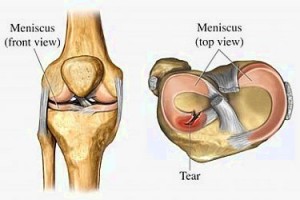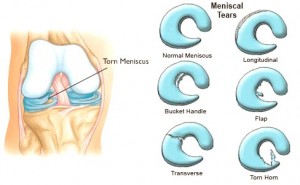Meniscal tear is a common occurrence among athletes or people who are active in sports as it is an injury against the knee or those who have arthritic knee pain. The knee is the largest joint in the human body and it is also the most complicated. Because the knee supports the whole body weight it is very vulnerable to injuries and one of the most common injury is the Meniscal tear.
Meniscal tear is an injury or a tear in the meniscus which act as lubricators, shock absorbers, stabilizers, and load distributors between knee joints. It is made up of cartilages which consist of two disks- the medial (inside) and lateral (outside) meniscus.
• Medial Meniscus is generally more prone to injuries. It is a structure that separates the tibia (shinbone) from the femur (thighbone). It serves as a shock absorber to help reduce friction between the bones for smoother and more balanced movements.
• Lateral Meniscus is a thick pad crescent shaped form that covers most parts of the articular surface. It acts as surface smoother for joints to move freely.
Types of Meniscal Tear
A meniscus tears in many different ways. The tears are determined in the way they look and the location of the injury. Some of these tears can be treated surgically and some are not.
• Frayed Edge
Damages caused by frayed edges are usually considered less serious. They are seen as ragged fronds at the sharp edges of a meniscus. Most surgeons correct these fray damages by trimming away the rough edges.
• Radial Tear
A radial tear is a sharp split in the inner rims toward the outer rims. This type of injury is usually treated through stitching but the inner injuries are less likely to heal because of poor blood supply but because this is the most important part of the meniscus, stitching is still the best option.
• Parrot Beak Tear
Parrot beak tear is an oblique shape type of neglected radial tear which may usually try to heal itself and may look like a parrot’s beak in time.
• Circumferential Tear
A circumferential tear is a tear that usually extends its length along the meniscus or the circumference.
• Bucket Handle Tear
When tears go through within the depths of the meniscus, these injuries have tendency to flip over the femur side which results to joint locking. These injuries can get worse and treatment is only through surgery.
• Horizontal Cleavage Tear
The horizontal split along the meniscus body is called horizontal cleavage tear. This is an unusual type of tear that may seem at first look just like a minor injury but in the deeper surface a bigger tear maybe present that can only be seen through an MRI scan.
• Flap Tear
Flap tear is a horizontal type of tear visible at the meniscus surface. It’s easier to be treated by just trimming the flap section away.
Causes
Most common cause of meniscal tears are traumatic injuries and degenerative processes. These traumatic movements include sudden twisting and joint locking which is very common to most athletes. And as people get older the meniscus also weakens which makes simple movements like squatting or walking along uneven surface can cause meniscal tear. Degenerative meniscal tear is most common to people who smoke.
Signs and Symptoms of Meniscal Tear
Meniscal tear may or may not manifest any signs or symptoms depending on its severity. Symptoms that need to be watched out for include:
• A popping sound at the time of injury
• Pain in the knee joint especially when walking
• Knee pain that gets worse when applied with a gentle pressure
• Tightness and swelling
• Knee joint locking
• Difficulty in moving or squatting
Diagnosis and Meniscal Tear Treatment
To evaluate an injured knee, the physician will first ask the patient’s history and the cause of injury. Next, he or she will perform a thorough physical examination by examining the injury site and may also require an X-ray, MRI scan and arthroscopy examination to help determine the degree of the injury. If the patient’s history and the test findings indicate that a meniscal tear is present, an arthroscopic surgery may be performed. But for minor injuries physical therapy and anti-inflammatory medications may be enough.
After Care and Meniscal Tear Physiotherapy
After a person gets injured, there is a series of guidelines to be followed for fast recovery. RICE therapy is recommended for patients with minor injuries:
• Rest – is essential to give respite to the injured knee.
• Ice – is applied within 24 hours after the injury to reduce swelling, pain and inflammation.
• Compression – helps the injured site to stop from swelling and it also gives support and protection.
• Elevate – the injured knee within the first 24 hours to help reduce swelling and drain the fluids.
For fast recovery patients need physical therapy, strict compliance to the doctor’s approved exercises and restraining from doing rigorous physical activities for a few months.
Prevention
To avoid meniscal tear injuries a person should wear proper footwear and sports gear. Strengthening and stretching of leg muscles, and learning to properly execute techniques in cutting, pivoting, slowing down and landing from a jump would help avoid meniscal injuries. For the elderly, being extra careful in their activities is the best way of prevention.

